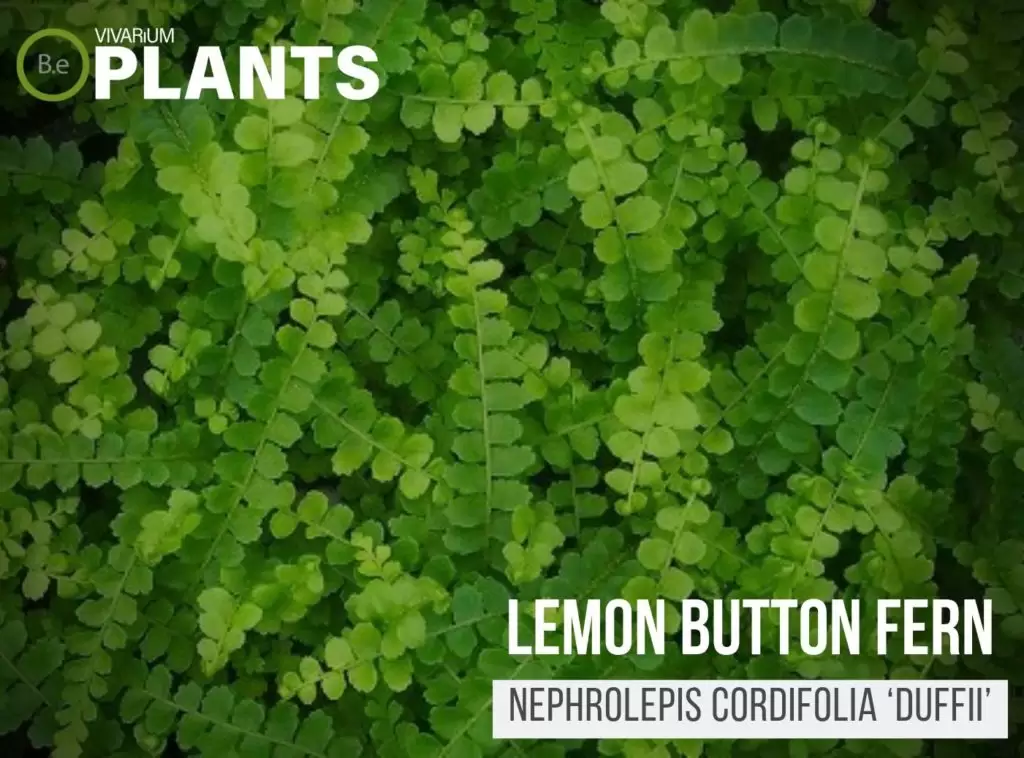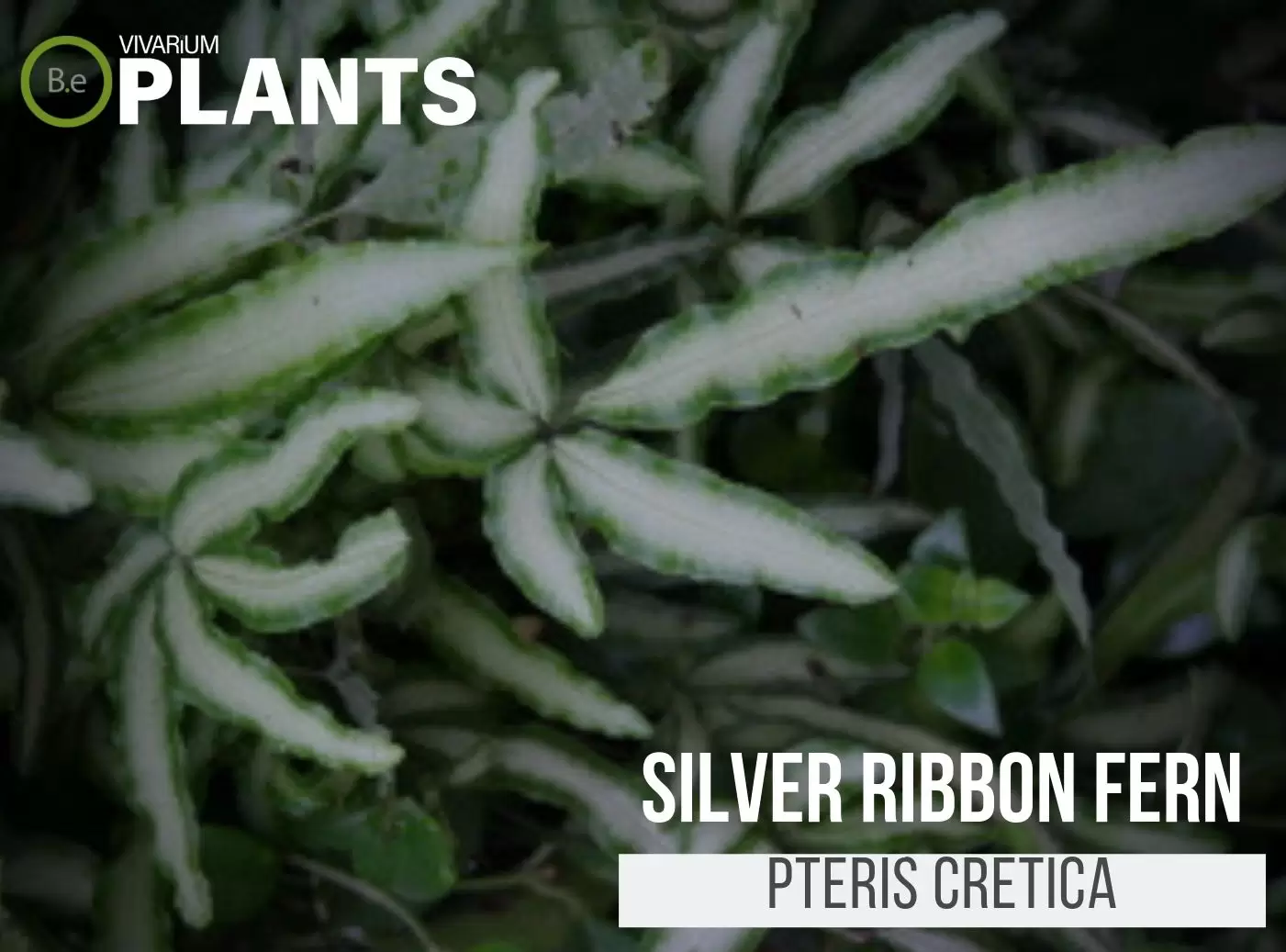Silver Lace Fern (Pteris ensiformis) is a very vibrant flora to add to an enclosure.
This plant exhibits an array of bright vivid colors that can significantly add life and diversity to fairy gardens as well as terrariums.
The tropical climate this fern is comfortable with paired with the low care requirements it desires makes it an excellent terrarium fern to have in a collection.
This article will cover all the essential information needed to care for this type of Pteridaceae.
| Quick Stats: | |
|---|---|
| Scientific Name | Pteris ensiformis ‘evergemiensis’ |
| Common Name | Silver Lace Fern, Slender Brake Fern, Sword Brake Fern, Variegated Brake Fern |
| Family Name | Pteridaceae |
| Habitat | Tropical, Subtropical |
| Temperature | 60°F to 75°F |
| Height | 12 to 16 inches |
| pH | 5.6 to 7.0 |
| Lighting | Bright |
Table Of Contents:
ToggleWhat Is Silver Lace Fern?
Pteris ensiformis ‘evergemiensis’ is a species of brake fern that grows in clusters of flat, oval-shaped leaves.
The splashes of white color pouring throughout the leaves and stems of this plant have garnished it the common name, Silver Lace Fern.
Depending on what part of the world you ask, there are many uses for this plant besides tank aesthetics…
This variegated plant thrives in shaded moist areas, making it ideal for use indoors.


Silver Lace Fern Facts
Other than the Silver lace fern, Pteris ensiformis is also commonly known as the Slender brake fern, Sword brake fern, and Variegated brake fern.
All of its many common names are references to the plant’s distinctive look and are often variations of names to other ferns similar in appearance.
For instance, brake plants are a type of various ferns that all have leaves that branch out in a very uniform, feather-like way.
Silver lace and variegated both refer to the multiple shades of white this type of fern exhibits.
The sword and slender terms obviously point out the narrow, oval-like shape the individual leaves make as they grow.
Description
Silver lace ferns have a very striking appearance that easily makes them identifiable when compared to other types of ferns.
The clusters of green and white striped stems that grow out from this plant can reach as tall as 16 inches in length.
The most noticeable feature of this fern is its multicolored arrangement of fronds.
Variegated brake fern has a pinnate of leaves that have a cream-white colored center and fade into a bright green color towards the trim.
These lace-textured leaves can grow out to be as long as six inches. The root system of this fern is in the form of rhizomes.
Rhizomes are balls of roots that grow in masses allowing the fern to absorb needed nutrients from the substrate it is planted in.
The silver lace fern uses spores to propagate but will often sprout new clusters of stems from roots that venture far enough away from the parent rhizome.
This plant can grow quite big if left unpruned, reaching heights as high as 18 inches and widths as wide as 16 inches.
Habitat
The native habitat of Silver lace fern is usually a damp, humid tropical or subtropical environment.
This plant’s origin is found in Southeast Asia, China, and parts of Polynesia.
Being a fairly hardy plant, this fern can handle temperatures as low as 55 degrees Fahrenheit but the ideal habitat should stay between 60 and 75 degrees.
This fern is a shade-dependent plant mostly growing in areas where trees provide a nice canopy out of direct sunlight.
PH Preference
When comparing this plant to other ferns, it can seem to be a more alkaline tolerate plant. Silver lace ferns still very much need lower ph water conditions to survive.
Ideal pH levels should stay around the 6.0 mark but the variegated fern can tolerate neutral levels of water around 7.0 for a period of time.
I would recommend keeping the soil acidic so that there is room for sweeter water parameters if no choice is warranted.
Vivarium Type
This type of fern will do great in a variety of vivarium types. Aim to put silver lace fern in enclosures that have a good amount of land space available.
Aquatic features are not necessarily required to maintain a healthy habitat but totally acceptable as long as this plant and its root system aren’t in direct contact with that area.
Here are recommended vivariums Silver Lace Fern will do well in:
- Paludariums – Half aquatic/ half terrain-based enclosure.
- Terrariums – Fully terrain-based enclosures with little to no aquatic features.
Vivarium Placement
As I mentioned earlier, silver lace fern is a terrestrial-based plant. It will not do well partially submerged or fully placed underwater.
However, it does thrive in a moderately damp, well-drained substrate.
The best place for this fern will be the background area where it has room to fill out and provide fullness to the enclosure.
This is an accenting plant that shouldn’t be the bulk of the setup but provide a nice elegant supplement of color to add to the existing habitat.
Many inhabitants will find that this plant can become the perfect shelter of refuge to safely slip away when stressed.
Substrate
The ideal substrate for a brake fern should consist of a fluffy, damp acidic mix of soil.
It should be soft enough for the fern to easily root through, yet firm enough to hold the weight of the plant in the upright position.
I would recommend a mix of peat moss and sand or soil depending on what plants are coexisting in the same enclosure.
The best depth of soil should be deep enough to bury the base of the fern up to its rhizome, leaving the top of the crown exposed.
The substrate should be kept damp but also well-drained allowing excess water from watering to easily pour completely through the substrate.
Lighting
The natural habitat of silver lace fern is a bright tropical environment with plenty of shade provided by a canopy of taller trees.
Like many ferns, this plant does not do well exposed to direct sunlight. Mimicking the luminance of this type of habitat can be fairly easy to do in a vivarium.
Aim for strong artificial lighting in the form of LEDs and avoid placing the vivarium near windows where sunlight can interfere with the ecosystem.
Sunlight causes the fern to dry out and wither away fronds quickly.
On that note, it would be a good suggestion to avoid lighting that produces UV lighting as well for the same reason.
Buy Silver Lace Fern
When shopping for silver lace fern, expect a few key indicators you are buying the best quality plant.
The fern should be slug free along with any other type of pest. The source of the fern will usually be sold in a small potted cluster, ready for you to re-pot.
The batch should arrive fairly damp and in fairly good shape. Click the image below to find out more about the current price and other relative info:




Silver Lace Fern Care and Propagation
Pteris ensiformis ‘evergemiensis’ can be a fairly easy fern to grow and care for. Keeping a few essential factors in mind will assure the healthy production of this plant.
Taking into consideration some of the things previously discussed earlier in this article like the preferred substrate, lighting, and water parameters already puts you one step ahead with the caretaking aspect of silver lace fern.
Here are a few more tips to aid in the propagation of this plant:
How to grow
In the wild, Silver lace fern uses the spore method to produce new colonies of vegetation. You may also notice new stims immerge from the soil around the parent clump as well.
Dividing the rhizome into individual pieces is the typical way a hobbyist will start a new batch of Pteris.
This plant has the ability to regrow an entirely new clutch of foilage if there is enough of at least a stim and frond attached to the separating roots.
Once the separation of the intended plant has been accomplished, replant the fern in the new location and water it generously.
Make sure not to over-bury the rhizome and allow the top half of the ball to remain above the soil.
Watering
The suggested watering practice for this brake fern will be to water as needed.
The watering demand for Pteris ensiformis ‘evergemiensis’ is high so a good rule of thumb would be to keep the top surface of the soil damp at all times.
A well-drained substrate will allow excessive amounts of water to completely run through the substrate.
This is a plant that does well in constant moisture. If using a mister or fogger, silver lace fern should spend the majority of the day in high humidity with plenty of additional watering…
Plants Similar To Silver Lace Fern
Adding diversity to an enclosure is key to an aesthetically pleasing enclosure.
Try mixing up the look of your vivarium with different flora that can easily co-exist in the same types of environment.
Furthermore, if for some reason you find this fern hard to acquire or would like to consider something similar to this plant…
Here are some other plants you might find may do well with or in place of Pteris ensiformis:
Conclusion
I really enjoy the aesthetics Silver lace fern offers an enclosure. It is a great terrarium plant to put in the background area of a tank where it provides variance and maturity to an environment.
This is one of the best takeaways of this fern besides its unique look, is its tolerance.
Pteris is a very forgiving and hardy plant to work with making it perfect for a beginner. The tropical habitat this plant thrives in can easily be reproduced in terrariums.
Avoid putting this fern directly in aquariums where there are no dry areas of land or dry desert-like terrariums. I personally think the Silver lace fern is perfect for paludariums!
Frequently Asked Questions
To take care of a Silver Lace Fern (Pteris ensiformis), you should give it a warm and humid environment with indirect sunlight. Place the plant in a well–drained soil and keep the soil evenly moist. For an extra boost, fertilize with a balanced 10–10–10 fertilizer once a month. Prune dead or yellowing fronds regularly to promote healthy growth. Keep an eye out for pests, particularly spider mites and mealybugs, and act quickly to eradicate them.
Yes! Silver Lace Fern (Pteris ensiformis) is relatively easy to care for and perfect for adding texture to low–light areas of your home or terrarium. The best part is, it’s tolerant of neglect, so you don’t need to worry about overwatering or failing to give it enough sunlight. Just make sure you keep it moist to maintain its lushness.
Silver Lace Fern (Pteris ensiformis) requires bright but indirect sunlight. Its best growth is achieved with several hours of indirect sunlight each day, ideally filtered through sheer curtains, shades, or using LEDs.
For Silver Lace Ferns (Pteris ensiformis), it is recommended to water consistently throughout the year by sprinkling the soil with water so it’s lightly damp. This should be done about once a week to every two weeks, making sure the soil is allowed to dry out slightly between waterings.
Silver Lace Fern (Pteris ensiformis) is a unique plant with its lacy, pale green fronds that create an exquisite texture and look. Its leaves are deeply cut into around 12–14 pairs of pinnae (individual leaflets). This fern is considered an evergreen, as it does not lose its leaves in the winter, and it is relatively heat and drought tolerant. The fern can live for many years and its tall, arching fronds make it a perfect choice for adding a touch of class to any garden, living space, or terrarium.


